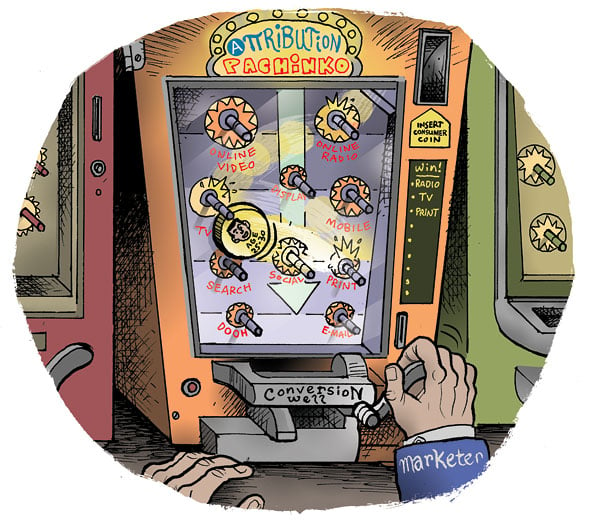As third-party cookies disappear, old marketing tricks reemerge.
It happened for contextual targeting and direct deals. Now media mix modeling (MMM) – analyzing sales data over time to determine which marketing tactics drive conversions – just might be due for a resurgence.
But for MMM to truly have a comeback, it needs to become more accessible to mid-tier marketers – not just top-spending brands like in the past.
The democratization of MMM is the main idea behind the launch of marketing analytics platform FutureSight.online, its founder Marilois Snowman told AdExchanger. Originally incubated as a product for ad agency Mediastruction, the platform’s debut is especially timely since MMM can gauge incrementality when identifiers like third-party cookies or alternative IDs aren’t present.
As brands look for new ways to prove their online and offline marketing efforts produce results, Snowman said, “those breadcrumbs that used to take you from exposure across various digital channels to that online cart are going away.”
MMM for all
But MMM isn’t just back in vogue because cookies are passé.
MMM is also benefiting from advancements in data science and computing power, which allow it to be deployed at a more granular level, said Joshua Chasin, a strategic advisor for FutureSight. Chasin is also former chief measurability officer at VideoAmp and a member of the Advertising Research Foundation’s board of advisors.
For example, now brands can more easily differentiate their marketing impact between linear and connected TV, whereas before they would look at gross rating points.
But building a dedicated MMM for a brand could take up to 18 months and cost about $250,000, which makes this approach accessible only to top brands, Snowman said.
Instead, FutureSight sees an opportunity in making MMM attainable for mid-tier advertisers – namely, brands that spend between $1 million and $50 million per year on advertising.
To be clear, FutureSight can support larger brands, too, Snowman added. But she sees more opportunity in catering to the underserved middle of the market than in courting big-name clients.
And Snowman has experience serving the mid-market niche. She is also the founder and CEO of Mediastruction, a Boston-based ad agency that specializes in mid-market clients, which launched in 2011.
Snowman originally invested in FutureSight as a way for Mediastruction to distinguish itself from other mid-market agencies that didn’t have data-based planning tools. But she saw an opportunity to market it as a standalone offering that’s accessible to Mediastruction clients and non-clients.
That midsize client pool typically includes regional banks, regional health care providers, local auto dealerships and other brands that have access to a lot of first-party data, but not enough resources to use it for customized campaign optimization.
Via the MMM platform, a credit union attributed a 2% increase in home equity loans to an increase in spend on digital ads. Interestingly, the ads were for both home equity loans and auto loans. The client realized that online ads for either type of loan actually drove conversions for both, so it deprioritized some of its print spending to increase its digital spend.
How it works
Functionally, the FutureSight platform takes the MMM algorithms Mediastruction has been building for its mid-market clients for the past several years and creates a client-facing dashboard.
The interface helps brands organize all the data they have from online and offline ad buying platforms in one place. They can also filter ad delivery data by cost center or region.
FutureSight assesses each type of ad exposure or marketing strategy and weighs how it impacted sales. Then it looks at the synergy between all these different tactics to determine the optimal mix of each.
Then, brands can “increase where they’re winning and cut back where they’re losing,” Snowman said.
Brands can also analyze their marketing efforts in context with other factors that could affect campaign performance. This context lets them attribute campaign results in a more effective way than last-click attribution, Snowman said.
For example, a regional bank could ingest data about its online media, but also the proportion of account openings that happen at physical branch locations, interest rates, competitive noise and its level of brand awareness in a given area. The platform can analyze the impact of all these different factors using its multi-touch attribution output.
FutureSight’s in-house machine learning model ingests that data through API integrations, uploads it to the cloud and refreshes its insights daily, so brands can analyze how these factors are affecting media performance.
All this modeling is based on the brand’s first-party data, without any third-party data layers.
The platform currently doesn’t have artificial intelligence (AI) capabilities that allow it to autonomously act on its data analysis, Snowman said. Instead, a human on the brand side must ultimately make all optimization decisions.
Building the business
Keeping decision-making in marketers’ hands jives with FutureSight’s goal of making mar tech designed by media people.
Over the past year, Snowman bootstrapped the FutureSight platform into an independent company without raising any outside funding.
As of now, the company has half a dozen clients, mainly in the financial and health care markets, which Snowman declined to name, citing nondisclosure agreements.
And it currently has a dozen employees. Its immediate hiring priorities include adding a data architect and more data engineering and customer success support.
But even as it invests in tech resources, Snowman wants to keep the company’s core identity intact.
“A lot of times, analytics platforms are built by data scientists, not necessarily built by media people for media people,” she said. “We know media, which I would say is a differentiator.”















